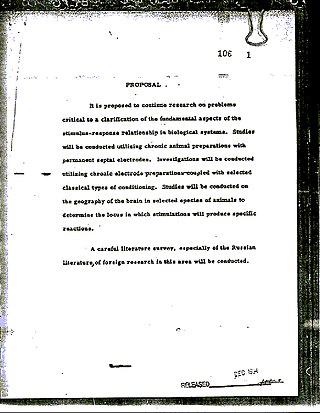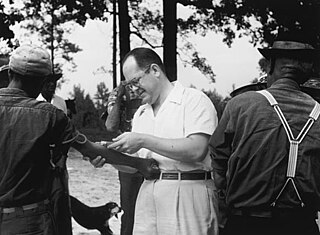
Project MKUltra was a human experimentation program designed and undertaken by the U.S. Central Intelligence Agency (CIA) to develop procedures and identify drugs that could be used during interrogations to weaken individuals and force confessions through brainwashing and psychological torture. The term MKUltra is a CIA cryptonym: "MK" is an arbitrary prefix standing for the Office of Technical Service and "Ultra" is an arbitrary word out of a dictionary to denominate this project.
3-Quinuclidinyl benzilate (QNB) is an odorless and bitter-tasting military incapacitating agent. BZ is an antagonist of muscarinic acetylcholine receptors whose structure is the ester of benzilic acid with an alcohol derived from quinuclidine.
Project Coast was a 1980s top-secret chemical and biological weapons (CBW) program instituted by the apartheid-era government of South Africa. Project Coast was the successor to a limited postwar CBW program, which mainly produced the lethal agents CX powder and mustard gas, as well as non-lethal tear gas for riot control purposes. The program was headed by the cardiologist Wouter Basson, who was also the personal physician of South African Prime Minister P. W. Botha.

The United States is known to have possessed three types of weapons of mass destruction: nuclear, chemical, and biological weapons. As the country that invented nuclear weapons, the U.S. is the only country to have used nuclear weapons on another country, when it detonated two atomic bombs over two Japanese cities of Hiroshima and Nagasaki during World War II. It had secretly developed the earliest form of the atomic weapon during the 1940s under the title "Manhattan Project". The United States pioneered the development of both the nuclear fission and hydrogen bombs. It was the world's first and only nuclear power for four years, from 1945 until 1949, when the Soviet Union produced its own nuclear weapon. The United States has the second-largest number of nuclear weapons in the world, after the Russian Federation.

MKNAOMI is the code name for a joint Department of Defense/CIA research program from the 1950s through to the 1970s. Unclassified information about the MKNAOMI program and the related Special Operations Division is scarce. It is generally reported to be a successor to the MKULTRA project focusing on biological projects including biological warfare agents—specifically, to store materials that could either incapacitate or kill a test subject and to develop devices for the diffusion of such materials.
Kolokol-1 is a synthetic opioid developed for use as an aerosolizable incapacitating agent. The exact chemical structure has not yet been revealed by the Russian government. It was originally thought by some sources to be a derivative of the potent opioid fentanyl, most probably 3-methylfentanyl dissolved in an inhalational anaesthetic as an organic solvent. However, independent analysis of residues on the Moscow theater hostage crisis hostages' clothing or in one hostage's urine found no fentanyl or 3-methylfentanyl. Two much more potent and shorter-acting agents, carfentanil and remifentanil, were found in the samples. They concluded that the agent used in the Moscow theater hostage crisis contained two fentanyl derivatives much stronger than fentanyl itself, sprayed in an aerosol mist.
Chemical, biological (CB) — and sometimes radiological — warfare agents were assigned what is termed a military symbol by the U.S. military until the American chemical and biological weapons programs were terminated. Military symbols applied to the CB agent fill, and not to the entire weapon. A chemical or biological weapon designation would be, for example, "Aero-14/B", which could be filled with GB, VX, TGB, or with a biological modification kit – OU, NU, UL, etc. A CB weapon is an integrated device of (1) agent, (2) dissemination means, and (3) delivery system.

From 1948 to 1975, the U.S. Army Chemical Corps conducted classified human subject research at the Edgewood Arsenal facility in Maryland. These experiments began after the conclusion of World War II, and continued until the public became aware of the experiments, resulting in significant outcry. The purpose was to evaluate the impact of low-dose chemical warfare agents on military personnel and to test protective clothing, pharmaceuticals, and vaccines. A small portion of these studies were directed at psychochemical warfare; grouped under the title "Medical Research Volunteer Program" (1956–1975), driven by intelligence requirements and the need for new and more effective interrogation techniques.
The United States biological weapons program officially began in spring 1943 on orders from U.S. President Franklin D. Roosevelt. Research continued following World War II as the U.S. built up a large stockpile of biological agents and weapons. Over the course of its 27-year history, the program weaponized and stockpiled seven bio-agents — Bacillus anthracis (anthrax), Francisella tularensis (tularemia), Brucella spp (brucellosis), Coxiella burnetii (Q-fever), Venezuelan equine encephalitis virus, Botulinum toxin (botulism), and Staphylococcal enterotoxin B. The US also pursued basic research on many more bio-agents. Throughout its history, the U.S. bioweapons program was secret. It was later revealed that laboratory and field testing had been common. The official policy of the United States was first to deter the use of bio-weapons against U.S. forces and secondarily to retaliate if deterrence failed.

Dimethylheptylpyran is a synthetic analog of THC, which was invented in 1949 during attempts to elucidate the structure of Δ9-THC, one of the active components of Cannabis. DMHP is a pale yellow, viscous oil which is insoluble in water but dissolves in alcohol or non-polar solvents.

EA-3167 is a potent and long-lasting anticholinergic deliriant drug, related to the chemical warfare agent 3-quinuclidinyl benzilate (QNB) and to the bronchodilator drug tiotropium bromide. It was developed under contract to Edgewood Arsenal during the 1960s as part of the US military chemical weapons program, in an attempt to develop non-lethal incapacitating agents. EA-3167 has identical effects to QNB, but is even more potent and longer-lasting, with an effective dose when administered by injection of as little as 2.5 μg/kg, and a duration of 120–240 hours. However unlike QNB, EA-3167 was never weaponized or manufactured in bulk.

The M43 BZ cluster bomb, or simply M43 cluster bomb, was a U.S. chemical cluster bomb intended to deliver the incapacitating agent known as BZ. The weapon was produced in the early 1960s and all stocks of U.S. BZ were destroyed by 1989.
The M138 bomblet was a sub-munition of the U.S. chemical weapon, the M43 BZ cluster bomb. The bomblet contained BZ, an incapacitating agent and was developed with the M43 in 1962. The M138s, along with all other U.S. BZ weapons were destroyed during the 1980s.
Entomological warfare (EW) is a type of biological warfare that uses insects to interrupt supply lines by damaging crops, or to directly harm enemy combatants and civilian populations. There have been several programs which have attempted to institute this methodology; however, there has been limited application of entomological warfare against military or civilian targets, Japan being the only state known to have verifiably implemented the method against another state, namely the Chinese during World War II. However, EW was used more widely in antiquity, in order to repel sieges or cause economic harm to states. Research into EW was conducted during both World War II and the Cold War by numerous states such as the Soviet Union, United States, Germany and Canada. There have also been suggestions that it could be implemented by non-state actors in a form of bioterrorism. Under the Biological and Toxic Weapons Convention of 1972, use of insects to administer agents or toxins for hostile purposes is deemed to be against international law.

Psychochemical warfare involves the use of psychopharmacological agents with the intention of incapacitating an adversary through the temporary induction of hallucinations or delirium. These agents, often called "drug weapons", are generally considered chemical weapons and, more narrowly, constitute a specific type of incapacitating agent.

EA-3834 is a potent anticholinergic deliriant drug with a fairly long duration of action, related to the chemical warfare agent 3-quinuclidinyl benzilate (QNB). It was developed under contract to Edgewood Arsenal during the 1960s as part of the US military chemical weapons program, during research to improve upon the properties of earlier agents such as QNB.

Numerous experiments which were performed on human test subjects in the United States in the past are now considered to have been unethical, because they were performed without the knowledge or informed consent of the test subjects. Such tests have been performed throughout American history, but have become significantly less frequent with the advent and adoption of various safeguarding efforts. Despite these safeguards, unethical experimentation involving human subjects is still occasionally uncovered.
The United States Biological Defense Program—in recent years also called the National Biodefense Strategy—refers to the collective effort by all levels of government, along with private enterprise and other stakeholders, in the United States to carry out biodefense activities.
James Sanford Ketchum was a psychiatrist and U.S. Army Medical Corps officer who worked for almost a decade (1960–1969) on the U.S. military’s top secret psychochemical warfare program at the Edgewood Arsenal, Maryland, which researched chemicals to be used to "incapacitate the minds" of adversaries.










